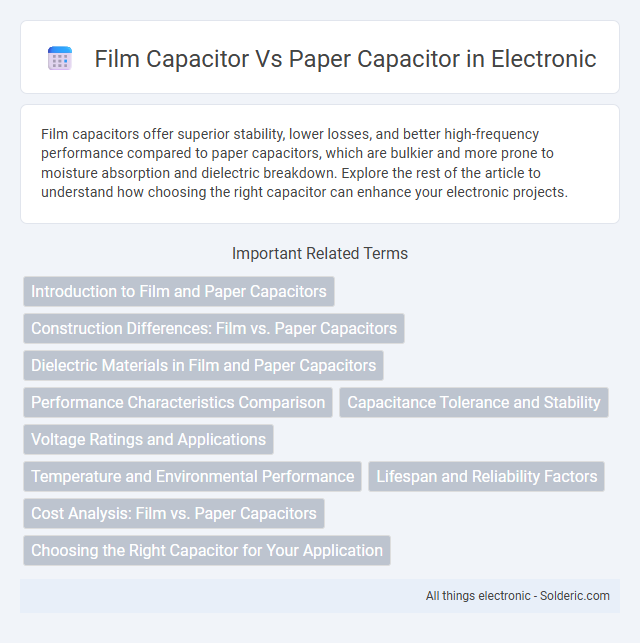Film capacitors offer superior stability, lower losses, and better high-frequency performance compared to paper capacitors, which are bulkier and more prone to moisture absorption and dielectric breakdown. Explore the rest of the article to understand how choosing the right capacitor can enhance your electronic projects.
Comparison Table
| Feature | Film Capacitor | Paper Capacitor |
|---|---|---|
| Dielectric Material | Plastic film (e.g., polyester, polypropylene) | Paper soaked in oil or wax |
| Capacitance Range | Few pF to several uF | Few nF to several uF |
| Voltage Rating | Up to several kV | Typically lower than film capacitors |
| Loss Factor (Dissipation) | Low dielectric loss | Higher dielectric loss |
| Frequency Response | Excellent for high-frequency applications | Limited high-frequency performance |
| Stability & Reliability | High stability, long lifespan | Less stable, prone to aging |
| Size | Compact and lightweight | Larger and bulkier |
| Cost | Typically higher | Generally lower |
| Common Applications | Audio circuits, power supplies, signal processing | High-voltage filtering, vintage electronics |
Introduction to Film and Paper Capacitors
Film capacitors use a thin plastic film as the dielectric material, offering high stability, low loss, and excellent insulating properties. Paper capacitors employ cellulose paper impregnated with oil or wax, which provides good dielectric strength but suffers from higher moisture absorption and aging effects. Your choice depends on the specific application requirements, including capacitance stability, voltage rating, and environmental conditions.
Construction Differences: Film vs. Paper Capacitors
Film capacitors consist of a thin plastic film as the dielectric material with metalized layers or foil electrodes, providing high insulation resistance and stability. Paper capacitors use impregnated paper as the dielectric sandwiched between metal foil layers, which results in lower insulation resistance and higher susceptibility to moisture and aging. Film capacitors offer improved durability, lower dielectric losses, and better performance under high-frequency conditions compared to paper capacitors.
Dielectric Materials in Film and Paper Capacitors
Film capacitors use dielectric materials like polyester, polypropylene, and polycarbonate known for their low dielectric losses and high insulation resistance, resulting in improved stability and longer lifespan. Paper capacitors employ cellulose-based paper impregnated with oil or wax, providing good dielectric strength but generally higher losses and lower reliability compared to film capacitors. Understanding the differences in dielectric materials helps you select the most suitable capacitor for your application's performance and durability requirements.
Performance Characteristics Comparison
Film capacitors offer superior performance characteristics compared to paper capacitors, including lower dielectric losses, higher insulation resistance, and better stability over a wide temperature range. Their self-healing properties and resistance to moisture enhance reliability and lifespan, making them ideal for high-frequency and precision applications. Your choice of capacitor significantly impacts circuit efficiency and durability, with film capacitors excelling in maintaining capacitance and minimizing signal distortion.
Capacitance Tolerance and Stability
Film capacitors typically exhibit capacitance tolerance ranging from +-1% to +-10%, providing superior stability under varying temperatures and frequencies compared to paper capacitors, which generally have wider tolerances around +-10% to +-20%. Stability in film capacitors remains consistent over time due to their synthetic dielectric materials, while paper capacitors tend to absorb moisture, leading to increased tolerance drift and reduced performance reliability. This makes film capacitors a preferred choice in precision applications requiring tight capacitance stability and minimal variation.
Voltage Ratings and Applications
Film capacitors typically offer higher voltage ratings, often exceeding several thousand volts, making them ideal for high-voltage applications such as power supplies, audio equipment, and motor run circuits. Paper capacitors generally have lower voltage ratings, ranging from a few hundred to around 1,500 volts, and are commonly used in older or legacy electronics where cost-effectiveness is a priority. When selecting capacitors for your design, choosing film capacitors ensures better performance in high-voltage environments, while paper capacitors remain suitable for lower-voltage, budget-sensitive applications.
Temperature and Environmental Performance
Film capacitors exhibit superior temperature stability and environmental resilience compared to paper capacitors, maintaining consistent capacitance and low loss up to temperatures around 105degC or higher. Paper capacitors, often impregnated with oil or wax, are more susceptible to moisture absorption, resulting in reduced dielectric properties and shorter lifespan in humid or variable temperature environments. This makes film capacitors the preferred choice for applications requiring long-term reliability under fluctuating thermal and environmental conditions.
Lifespan and Reliability Factors
Film capacitors offer significantly longer lifespan and higher reliability compared to paper capacitors due to their stable dielectric materials, which resist moisture and degradation over time. Paper capacitors are prone to aging, insulation breakdown, and reduced performance, especially in humid or high-temperature environments. Selecting film capacitors enhances Your device's durability and ensures consistent electrical performance under various operational stresses.
Cost Analysis: Film vs. Paper Capacitors
Film capacitors generally offer a higher cost efficiency over paper capacitors due to their longer lifespan and superior reliability, which reduces replacement and maintenance expenses. Paper capacitors tend to have lower initial costs but incur higher total ownership costs because of their susceptibility to moisture and degradation. When evaluating cost analysis, film capacitors provide better long-term value in industrial and electronic applications despite a slightly higher upfront price.
Choosing the Right Capacitor for Your Application
Film capacitors offer superior stability, low ESR, and excellent frequency performance, making them ideal for audio, filtering, and precision timing applications compared to paper capacitors. Paper capacitors, although less common today, may still be chosen for vintage equipment restoration due to their characteristic dielectric properties and cost-effectiveness. Selecting the right capacitor depends on factors like voltage rating, tolerance, operating temperature, and application frequency, where film capacitors generally provide better long-term reliability and reduced dielectric absorption.
film capacitor vs paper capacitor Infographic

 solderic.com
solderic.com